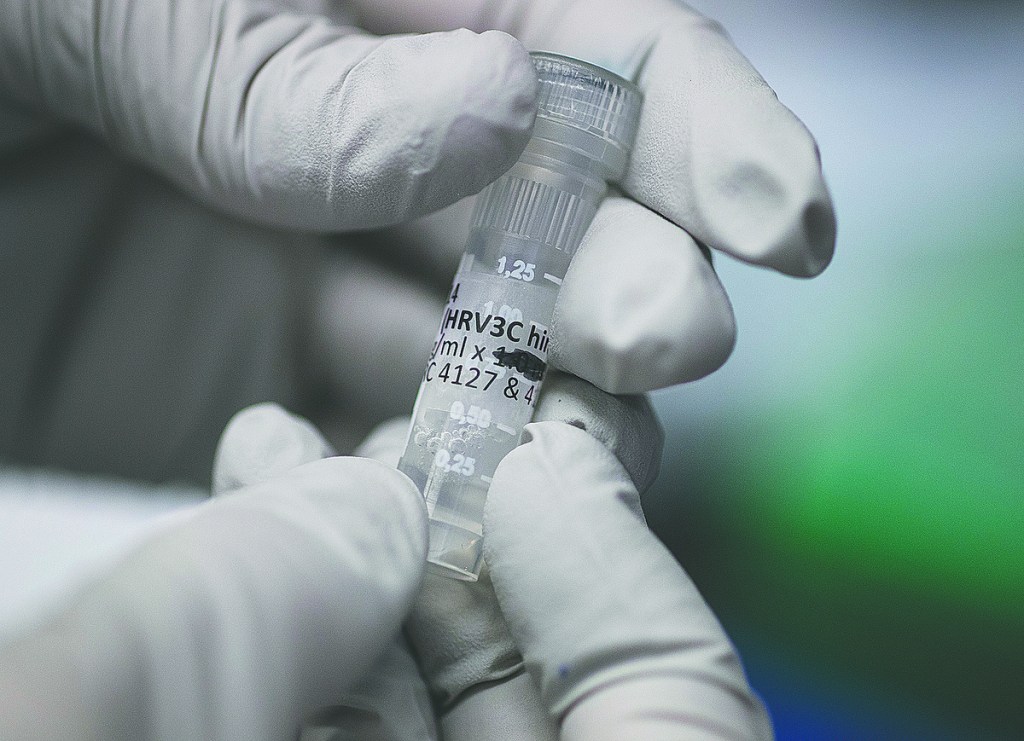Positive flu tests have spiked in Teche Area in Dec. and Jan.
Published 5:00 am Tuesday, January 23, 2018

- A research scientist holds a flu vaccine in a lab. This flu season has hit Louisiana hard and the Teche Area is no exception. Iberia Medical Center had 355 people test positive for the flu in December, and already has 428 people test positive in January.
Louisianans were hit hard by the flu this year, and New Iberia was no exception.
The spike in cases came about half way through December, and has been unrelenting through January so far.
At the Iberia Medical Center, less than 10 percent of flu tests came back positive in October and November, when 48 people tested positive for the two months combined; in December, that number jumped to 355 people — 32 percent of the 1,081 tests conducted.
In January so far, the IMC has had 428 positive tests of 1,096 given, or 39 percent.
The vast majority of those positives are for Influenza Type A, according to IMC Infection Prevention Specialist Ashley Langlinais, RN BSN.
“If you think you are sick, we advise people to stay home,” said Langlinais. “Certainly, contact a doctor and get it checked out, but try to avoid going out and limit public interactions while sick.”
Langlinais said to remain home with limited interaction with others for at least seven days from the onset of symptoms, or after going 24 hours without experiencing symptoms associated with fever — whichever is longer.
Otherwise, she said, hygiene is of utmost importance.
“It’s pretty simple advice, but just make sure to wash your hands often. Wash your hands any time you blow your nose, before you eat, things like that. Try to avoid touching areas of your face like the mouth, nose and eyes,” she said.
Several reports have suggested that the flu vaccines distributed this year were far less effective against the strains that wound up spreading most. Frank Garber, NP at Iberia Urgent Care, on Lewis Street, attributed the jump in flu cases, at least in part, to that.
“The flu shot did not cover the strain that we’re seeing this year, and that has set us up for significant numbers,” he said. “We’ve been very busy.”
The same is true for Dr. Jose Mata, of the Family Medicine Clinic in New Iberia.
“We are experiencing a large amount of flu this year. The hospitals in the area are overwhelmed. The ER’s are running constantly,” he said.
Similar, significant rises have been seen across the state, the south and, to a lesser extent, the country. A color-coded map of the U.S. recently published by the CDC has a thick band of red indicating high levels of flu activity running across the bottom half to two-thirds of the country, beginning in Oregon and California but sweeping through every southern state except for Florida, to Virginia and West Virginia. (And Florida levels are also high, but it is coded orange, slightly lower than the rest of the south.) The federal Centers for Disease Control and Prevention have received reports from epidemiologists in almost 40 states of widespread influenza activity currently.
“The only state that is not doing badly, I think, is Hawaii,” Mata said.
Despite questions over the efficacy of this year’s vaccine, all medical experts contacted universally encouraged people to get vaccinated if they haven’t already.
“Some people might think, ‘Oh, well, it’s too late to take the flu shot, or it doesn’t work,’” Langlinais said. “We highly recommend, even if they haven’t yet done so, to vaccinate themselves. Especially high risk populations — if you’re pregnant, if you’re over 65, or very young children.”
“Some think the type A flu strain going around now, which is the H3N2 strain, is not covered by the vaccine, so they ask, ‘should you still get vaccinated?’” Mata said. “The answer is absolutely ‘yes.’ Some people say, ‘I never get sick.’ Well, it only takes one time. And the other reason is that, the more people that get vaccinated in an area, the less chance it has of spreading. If you don’t want to do it for yourself, do it for your family members,” he said.
He said current vaccines are still between 35 and 39 percent effective.
“Think about it like this: if there are a thousand people, and you can prevent 390 of them from getting sick, you’ve done some good,” he said. “It’s not too late to get the flu shot. It’s better than nothing.”





